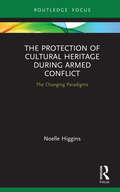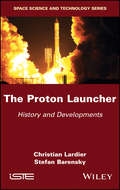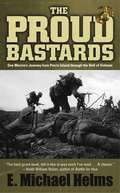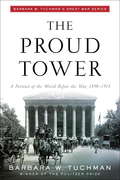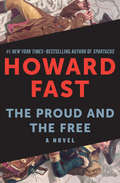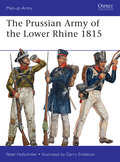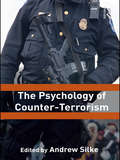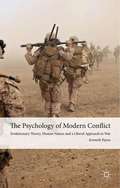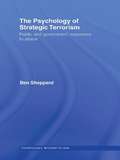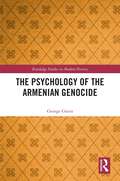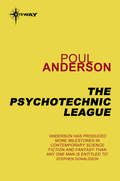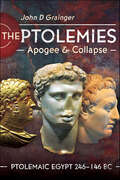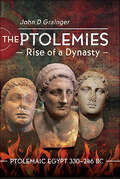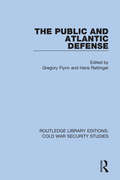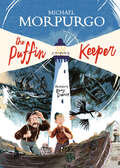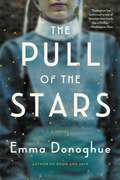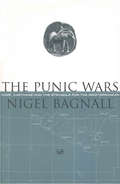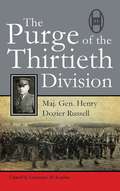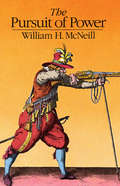- Table View
- List View
The Protection of Cultural Heritage During Armed Conflict: The Changing Paradigms
by Noelle HigginsThis book analyses the current legal framework seeking to protect cultural heritage during armed conflict and discusses proposed and emerging paradigms for its better protection. Cultural heritage has always been a victim of conflict, with monuments and artefacts frequently destroyed as collateral damage in wars throughout history. In addition, works of art have been viewed as booty by victors and stolen in the aftermath of conflict. However, deliberate destruction of cultural sites and items has also occurred, and the Intentional destruction of cultural heritage has been a hallmark of recent conflicts in the Middle East and North Africa, where we have witnessed unprecedented, systematic attacks on culture as a weapon of war. In Iraq, Syria, Libya, Yemen, and Mali, extremist groups such as ISIS and Ansar Dine have committed numerous acts of iconoclasm, deliberately destroying heritage sites, and looting valuable artefacts symbolic of minority cultures. This study explores how the international law framework can be fully utilised in order to tackle the destruction of cultural heritage, and analyses various paradigms which have recently been suggested for its better protection, including the Responsibility to Protect paradigm and the peace and security paradigm. This volume will be an essential resource for scholars and practitioners in the areas of public international law, especially international humanitarian law and cultural heritage law.
The Proton Launcher: History and Developments
by Christian Lardier Stefan BarenskyThe Soviet / Russian space program was in the hands of three industrial empires: those of Serguei Korolev, the Soviet von Braun who launched Sputnik-1 and Yuri Gagarin, Vladimir Tchelomei, his main competitor, and Mikhail Yangel, Many launchers and satellites in Ukraine.In 2011, we published a first book on the history of the Soyuz launcher that was developed by Korolev and launched more than 1,800 copies. This time, we tell the story of the Proton, the main competitor of the European launcher Ariane, which was developed by Chelomei and launched more than 400 copies. Finally, the last book of the trilogy will deal with the many developments of Yangel. In the three books, the first part deals with the history of rockets in the USSR / Russia (East) and the second part on the history of their commercialization in the West.
The Proud Bastards: One Marine's Journey from Parris Island through the Hell of Vietnam
by E. Michael HelmsIn 1967, a young E. Michael Helms boarded a bus to the legendary grounds of Parris Island, where mere boys were forged into hardened Marines -- and sent to the jungles of Vietnam. It was the first stop on a journey that would forever change him -- and by its end, he would be awarded the Purple Heart Medal, Combat Action Ribbon, Presidential Unit Citation, Navy Unit Citation, and the Vietnam Cross of Gallantry. From the brutality and endurance-straining ordeals of boot camp to the endless horror of combat, Helms paints a vivid, unflinchingly realistic depiction of the lives of Marines in training and under fire. As powerful and compelling a battlefield memoir as any ever written, Helms's "grunt's-eye" view of the Vietnam War, the men who fought it, and the mindless chaos that surrounded it, is truly a modern military classic.
The Proud Tower
by Barbara W. TuchmanThe Proud Tower, the Pulitzer Prize-winning The Guns of August, and The Zimmerman Telegram comprise Barbara W. Tuchman's classic histories of the First World War era. During the fateful quarter century leading up to World War I, the climax of a century of rapid, unprecedented change, a privileged few enjoyed Olympian luxury as the underclass was "heaving in its pain, its power, and its hate." In The Proud Tower, Barbara W. Tuchman brings the era to vivid life: the decline of the Edwardian aristocracy; the Anarchists of Europe and America; Germany and its self-depicted hero, Richard Strauss; Diaghilev's Russian ballet and Stravinsky's music; the Dreyfus Affair; the Peace Conferences in The Hague; and the enthusiasm and tragedy of Socialism, epitomized by the assassination of Jean Jaurès on the night the Great War began and an epoch came to a close.
The Proud and the Free: A Novel
by Howard FastA soldier in the American Revolution must struggle for his country&’s existence and its most precious ideals—even though it means fighting against his commanding officersIn 1781, Jamie Stuart is a twenty-three-year-old soldier serving amongst Jews, free slaves, Catholics, Native Americans, and others grouped together in a &“Foreign Brigade.&” They are part of a larger Pennsylvania Line that is forced to fight without pay, re-enlist without end, and survive without basic provisions. Enslaved and abused, Stuart and his friends join the mutiny of the entire Pennsylvania Line against its officers, holding their superiors accountable to the principles promised by their developing nation. In The Proud and the Free, Fast brilliantly imagines a forgotten moment in American history that marked one of the nation&’s earliest struggles for freedom against tyranny. This ebook features an illustrated biography of Howard Fast including rare photos from the author&’s estate.
The Proud: An Illustrated History of the 6th Australian Division, 1939-1946
by Mark JohnstonFollowing Mark Johnston's acclaimed illustrated histories of the 7th and 9th Australian Divisions, this is his long-awaited history of the 6th Australian Division: the first such history ever published. The 6th was a household name during World War II. It was the first division raised in the Second Australian Imperial Force, the first division to go overseas and the first to fight. Its success in that fight, in Libya in 1941, indicated that the standard established in the Great War would be continued. General Blamey and nearly every other officer who became wartime army, corps and divisional commanders were once members of the 6th Division. Through photographs and an authoritative text, this book tells their story and the story of the proud, independent and tough troops they commanded.
The Prussian Army of the Lower Rhine 1815
by Gerry Embleton Peter HofschröerFor those interested in the actual appearance of the Prussian soldiers who fought at Ligny, Wavre and Waterloo in 1815, this colorful study combines the latest findings and expert analysis to cast new light on the fateful Waterloo campaign.The Prussian Army of the Lower Rhine, led by Generalfeldmarschall Gebhard Leberecht von Blücher in 1815, played a - possibly the - vital part in the Allied victory at Waterloo, forcing Napoleon to divide his forces when Blücher's leading elements arrived to offer Wellington crucial support at a time when his Anglo-Netherlands army was doing no more than holding its own on the defensive. During this campaign Blücher's army presented an enormously diverse appearance, since its units had been issued clothing and equipment from many sources, and many of them were still wearing the distinctly hard-worn kit they had been issued over two years before at the start of the 1813 Wars of Liberation.Written by a leading authority, this book delves deeply into original sources - including eyewitness accounts, and regimental histories known only to German scholars - to recreate the actual appearance of specific units, rather than simply copying generic uniform regulations. The text details who the men that served in these units were, how they were organised and drilled, and their previous service; what specific elements of the army looked like in 1815; their march to the battlefield; and what they did when they got there.
The Psychology of Counter-Terrorism (Political Violence)
by Andrew SilkeThis edited book explores how psychology can be used to improve our understanding of terrorism and counterterrorism. This work firstly aims to provide balanced and objective insight into the psychology of terrorists; what their motivations are, what keeps them involved in terrorist groups, and what eventually forces most to end their active involvement in terrorism. Secondly, the contributors focus on the challenging issue of how to respond to terrorism. These chapters provide information for those concerned with short-term tactical problems (e.g. interviewing), as well as those looking towards the more long-term strategic questions of bringing an entire terrorist campaign to an end. Ultimately, the individuals involved in terrorism require a more complex response from society than simply a quest for their apprehension. Believing inaccurate and misleading characterizations leads inevitably to damaging policies and deficient outcomes and campaigns of violence are needlessly prolonged. It is from this perspective that the concern arises with how researchers – and the policy makers guided by them – perceive the psychology of terrorists and of terrorism. This innovative book will be of great interest to students of terrorism and counter-terrorism, security studies, psychology and politics, as well as security professionals and military colleges.
The Psychology of Modern Conflict
by Kenneth PayneWhat does modern warfare have in common with our human evolution? In this study, Dr Kenneth Payne argues that there is an important relationship between the two – we have evolved to fight, and traditional hunter-gatherer societies were often violent places. But we also evolved to cooperate and to behave altruistically towards others. Both these evolutionary legacies can help explain how and why liberal societies fight. Payne considers the evidence for warfare in hunter gatherer communities, and explores how a process of 'domestication' some 10,000 years ago led to larger groups of more social and culturally sophisticated humans. He then considers how this #65533;ber-sociability is manifest in liberal societies in the modern era, underpinning our sense of empathy and moral values.
The Psychology of Radical Social Change: From Rage to Revolution
by Jaan Valsiner Fathali M. Moghaddam Brady WagonerSince 2011 the world has experienced an explosion of popular uprisings that began in the Middle East and quickly spread to other regions. What are the different social-psychological conditions for these events to emerge, what different trajectories do they take, and how are they are represented to the public? To answer these questions, this book applies the latest social psychological theories to contextualized cases of revolutions and uprisings from the eighteenth to the twenty-first century in countries around the world. In so doing, it explores continuities and discontinuities between past and present uprisings, and foregrounds such issues as the crowds, collective action, identity changes, globalization, radicalization, the plasticity of political behaviour, and public communication.
The Psychology of Strategic Terrorism: Public and Government Responses to Attack (Contemporary Terrorism Studies)
by Ben SheppardThis new volume explores terrorism and strategic terror, examining how the public responds to terrorist attacks, and what authorities can do in such situations. The book uses a unique interdisciplinary approach, which combines the behavioural sciences and international relations, in order to further the understanding of the 'terror' generated by strategic terror. The work examines five contemporary case studies of the psychological and behavioural effects of strategic terror, from either terrorist attacks or aerial bombardment. It also looks at how risk-communication and public-health strategies can amplify or reduce psychological and behavioural responses, and considers whether behavioural effects translate into political effects, and what governments can do to relieve this. Ultimately, the study argues that the public is not prone to panic, but can change their behaviours to reduce their perceived risk of being exposed to a terrorist attack. This book will be of much interest to students of terrorism studies, homeland security, social psychology and politics in general.
The Psychology of the Armenian Genocide (Routledge Studies in Modern History)
by George GreenThis book examines the radicalization of beliefs, tactics, and oppression by a dominant governing group when faced with a subordinate group’s historic quest for basic human rights dating back for five centuries. A unique approach, an analysis of archival documents, including minutes of Turkish meetings, provides a window into the inner workings and decision-making of the leaders. Their persuasive propaganda campaign is demystified by applying contemporary social psychological research to identify and explain their use of psychological mechanisms to weaponize intergroup prejudice and exclusionary ideology. Social antagonistic traits of the leader's ideology, dark personality traits, and propensity for moral disengagement are readily apparent in their highly effective propaganda campaign to gain the necessary support from their party and Turkish civilians for their genocidal agenda.The Psychology of the Armenian Genocide will appeal to scholars and students alike interested in better understanding how a nation of people can be manipulated to support the annihilation of subordinate groups. It will also appeal to a much wider range of people who would be interested in better understanding the manipulation of beliefs and morality to create intergroup divisions and intolerance for cooperation.
The Psychology of the Athenian Hoplite
by Jason CrowleyThroughout the Classical period, the Athenian hoplite demonstrated an unwavering willingness to close with and kill the enemies of Athens, whenever and wherever he was required to do so. Yet, despite his pugnacity, he was not a professional soldier; he was an untrained amateur who was neither forced into battle nor adequately remunerated for the risks he faced in combat. As such, when he took his place in the phalanx, when he met his enemy, when he fought, killed and died, he did so largely as an act of will. By applying modern theories of combat motivation, this book seeks to understand that will, to explore the psychology of the Athenian hoplite and to reveal how that impressive warrior repeatedly stifled his fears, mustered his courage and willingly plunged himself into the ferocious savagery of close-quarters battle.
The Psychotechnic League: Psychotechnic League Book 4 (PSYCHOTECHNIC LEAGUE)
by Poul AndersonIn the beginning was World War III...Out of the flames was born a new civilization, a new humanity dedicated to one world rather than to many nations, to once peace rather than many wars. Never again on Planet Earth would one group of humans "defend" themselves against another group equally convinced that all their actions were "defensive". Never again on Planet Earth.But cycles repeat themselves endlessly; Earth is only the beginning of the human story. Next comes planet against planet, and then the stars themselves. Through it all the impersonal forces of historical necessity will tend to force that story into the pathways of tyranny, stasis, and war. And in the end they must prevail. But ever will humankind win free once more...
The Ptolemies, Apogee & Collapse: Ptolemiac Egypt 246–146 BC
by John D. GraingerThe Second part of this ground-breaking trilogy covers the reigns of Ptolemy III, Ptolemy IV, Ptolemy V and Ptolemy VI. The second volume of this ground-breaking trilogy covers the reigns of Ptolemy II, III, IV, V and VI, who between them reigned for a century. Ptolemy III's rule brought the acquisition of Cyrenaica (through marriage) and territorial gains in Syria, the Aegean, Asia Minor and Thrace due to unexpected military successes in the Third Syrian War. These victories over the Seleukids, marked the apogee of Ptolemaic power. However, the rest of his reign was accompanied by internal trouble in Egypt. On Ptolemy III's death, his minister Sosibius organized the accession of Ptolemy IV, had the new king’s mother and siblings murdered and continued as effective ruler for the whole reign. He also dominated that of Ptolemy V. There was a surprising success in the Fourth Syrian War but this was followed by a major rebellion and defeat in the Fifth Syrian War, with the loss of Syria/Palestine and Ptolemaic holdings in Asia Minor. The murder of Ptolemy V in 180 was followed by the long and troubled reign of Ptolemy VI, one of the ablest of the Ptolemies, but hampered by continued trouble in Egypt and in the court. A disastrous war against the Seleukid Antiochos IV set back the Ptolemaic recovery. Ptolemy did eventually manage a complete victory, only to die of wounds received in battle. John Grainger clearly recounts and analyzes this dramatic period of war, politics, murder and court intrigue.
The Ptolemies, Rise of a Dynasty: Ptolemaic Egypt 330–246 BC
by John D. GraingerIn this first volume of his trilogy on the Ptolemies, John Grainger explains how Ptolemy I established the dynasty's power in Egypt in the wake of Alexander the Great's death. Egypt had been independent for most of the fourth century BC, but was reconquered by the Persian Empire in the 340s. This is essential background for Ptolemaic history since it meant that Alexander was welcomed as a liberator and, after the tyranny of Kleomenes, so was Ptolemy. This was the essential basis of Ptolemy’s power. He conciliated the Egyptians, but reinforced his military strength with Greek settlers, mainly retired or available soldiers. He built the city of Alexandria, but to his own requirements, not those planned by Alexander. The empire outside Egypt was acquired, perhaps for defence, perhaps by sheer greed. Ptolemy took over Cyrenaica (with difficulty), Cyprus and Syria/Palestine. These had to be defended against his rivals, hence the development of his navy, and the Syrian Wars. The succession was carefully managed, but was not directly hereditary (Ptolemy II was not the eldest son), and the new king was very different. He fought repeated wars in Syria, and in the Aegean, built up his navy to the greatest seen in the ancient world, and extended his empire into the lands of the Red Sea, Sudan and Ethiopia. He taxed the Egyptians mercilessly to fund all these activities. Yet few of his wars were successful, and he stored up trouble for his successors.
The Ptolemies, the Sea and the Nile
by Kostas Buraselis Mary Stefanou Dorothy J. Thompson Kostas Buraselis Mary StefanouWith its emphasis on the dynasty's concern for control of the sea – both the Mediterranean and the Red Sea – and the Nile, this book offers a new and original perspective on Ptolemaic power in a key period of Hellenistic history. Within the developing Aegean empire of the Ptolemies, the role of the navy is examined together with that of its admirals. Egypt's close relationship to Rhodes is subjected to scrutiny, as is the constant threat of piracy to the transport of goods on the Nile and by sea. Along with the trade in grain came the exchange of other products. Ptolemaic kings used their wealth for luxury ships and the dissemination of royal portraiture was accompanied by royal cult. Alexandria, the new capital of Egypt, attracted poets, scholars and even philosophers; geographical exploration by sea was a feature of the period and observations of the time enjoyed a long afterlife.
The Public and Atlantic Defense (Routledge Library Editions: Cold War Security Studies #39)
by Gregory Flynn; Hans RattingerThis book, first published in 1985, analyses the polarization of popular opinion over NATO defence policies during the latter years of the Cold War. In many countries, the domestic consensus that once supported Allied policies came close to collapsing, and this study examines the question of the democratization of defence policy. It explores four themes for each of the Allied countries: views of the Soviet Union; deterrence; security; and the Allies. A rigorous and systematic analysis of the raw data allows for easy cross-national comparisons.
The Puffin Keeper
by Michael MorpurgoFrom bestselling author Michael Morpurgo comes a beautifully illustrated classic story about a lighthouse keeper, a daring rescue and puffins, for fans of War Horse and The One and Only Ivan.As a child, Allen is saved from a nautical disaster by Benjamin Postlethwaite, a solitary lighthouse keeper. Years later, Allen returns to the lighthouse, and the two nurse an injured young puffin back to health. When Allen is called up to fight in World War Two, he's not sure he'll see his mother or Benjamin again, but his fond memories of his time at the lighthouse keep him going, even through prison camp. Allen and Ben's enduring friendship over the years is the basis for this story about friendship, art, war and an incredibly adorable puffin. From masterful storyteller Michael Morpurgo and world-class illustrator Benji Davies comes this truly beautiful tale which will enchant readers of all ages.
The Pull of the Stars: A Novel
by Emma DonoghueIn Dublin, 1918, a maternity ward at the height of the Great Flu is a small world of work, risk, death, and unlooked-for love, in "Donoghue's best novel since Room" (Kirkus Reviews). <p><p> In an Ireland doubly ravaged by war and disease, Nurse Julia Power works at an understaffed hospital in the city center, where expectant mothers who have come down with the terrible new Flu are quarantined together. Into Julia's regimented world step two outsiders -- Doctor Kathleen Lynn, a rumoured Rebel on the run from the police , and a young volunteer helper, Bridie Sweeney. In the darkness and intensity of this tiny ward, over three days, these women change each other's lives in unexpected ways. They lose patients to this baffling pandemic, but they also shepherd new life into a fearful world. With tireless tenderness and humanity, carers and mothers alike somehow do their impossible work. In The Pull of the Stars, Emma Donoghue once again finds the light in the darkness in this new classic of hope and survival against all odds.
The Punic Wars: Rome, Carthage and the Struggle for the Mediterranean
by Nigel BagnallThe Punic Wars (264-146BC) sprang from a mighty power struggle between two ancient civilisations - the trading empire of Carthage and the military confedoration of Rome. It was a period of astonishing human misfortune, lasting over a period of 118 years and resulting in the radical depletion of Rome's population and resources and the complete annihilation of Carthage. All this took place more than 2,000 years ago, yet, as Nigel Bagnall's comprehensive history demonstrates, the ancient conflict is remarkable for its contemporary revelance.
The Puppet Boy of Warsaw: A compelling, epic journey of survival and hope
by Eva WeaverI was twelve when the coat was made. Nathan, our tailor and dear friend, cut it for Grandfather in the first week of March 1938. It was the last week of freedom for Warsaw and for us...Even in the most difficult of lives, there is hope. And sometimes that hope comes in the form of a small boy, armed with a troupe of puppets - a prince, a girl, a fool, a crocodile with half-painted teeth....When Mika's grandfather dies in the Warsaw ghetto, he inherits not only his great coat, but its treasure trove of secrets. In one remote pocket, he finds a papier mache head, a scrap of cloth...the prince. And what better way to cheer the cousin who has lost her father, the little boy who his ill, the neighbours living in one cramped room, than a puppet show? Soon the whole ghetto is talking about the puppet boy - until the day when Mika is stopped by a German officer and is forced into a secret life...This is a story about survival. It is an epic journey, spanning continents and generations, from Warsaw to the gulags of Siberia, and two lives that intertwine amid the chaos of war. Because even in wartime, there is hope...Read by Tim Bruce(p) 2013 Oakhill Publishing
The Purge of the Thirtieth Division
by Henry Russell Lawrence M. KaplanThe Purge of the Thirtieth Division by Major General Henry Dozier Russell is the only known written work by any of the eighteen National Guard division commanders mobilized in1940 and 1941. It chronicles from a National Guard perspective many of the challenges and growing pains experienced by the Army in the critical months leading up to its entry into World War II. Through Russell, the reader gains insight into the vast cultural differences between the Regular Army and the National Guard at the time.Russell's memoir offer an invaluable source of a commander's first-hand account of how his division trained and fared during the 1940 Louisiana Maneuvers, and 1941 Tennessee and Carolina Maneuvers, respectively, in its preparation for overseas deployment. The narrative also contains a compelling account of the relations and tensions between Regulars and National Guardsmen. It was a scathing indictment of the Regular Army high command for what he perceived to be unfair treatment of National Guard officers during World War II. He cited many examples to bolster his claims, and contended that the U.S. Army, under Chief of Staff George C. Marshall, was out to "get" the Thirtieth Division and other National Guard divisions. He further contended that the Army believed that a non-Regular officer should not advance beyond the grade of lieutenant colonel. His memoir, which he privately printed, pulled no punches. His first-hand account was very critical of how a number of senior Regular Army officers handled affairs with his division that led to his relief as the division commander. Russell completed his memoir in 1947 and subsequently printed 500 copies, which he distributed to senior National Guard officers. He did not sell any of the books, nor were they intended for or made available to the general public. Although there was a demand for additional copies, he did not print any more. The republication of The Purge of the Thirtieth Division is intended to expand the scholarship on the history of World War II and the history of the U.S. Army.
The Pursuit of Power
by William H. McNeill“Remind[s] us that all humankind has a shared past and, particularly with regard to its choice of weapons and warfare, a shared stake in the future.” —Stuart Rochester, The Washington Post Book WorldIn this magnificent synthesis of military, technological, and social history, William H. McNeill explores a whole millennium of human upheaval and traces the path by which we have arrived at the frightening dilemmas that now confront us. McNeill moves with equal mastery from the crossbow—banned by the Church in 1139 as too lethal for Christians to use against one another—to the nuclear missile, from the sociological consequences of drill in the seventeenth century to the emergence of the military-industrial complex in the twentieth. His central argument is that a commercial transformation of world society in the eleventh century caused military activity to respond increasingly to market forces as well as to the commands of rulers. Only in our own time, suggests McNeill, are command economies replacing the market control of large-scale human effort. The Pursuit of Power does not solve the problems of the present, but its discoveries, hypotheses, and sheer breadth of learning do offer a perspective on our current fears and, as McNeill hopes, “a ground for wiser action.”“Mr. McNeill’s comprehensiveness and sensitivity do for the reader what Henry James said that Turgenev’s conversation did for him: they suggest ‘all sorts of valuable things.’ This narrative of rationality applied to irrational purposes and of ingenuity cannibalizing itself is a work of clarity, which delineates mysteries. The greatest of them, to my mind, is why human beings have never learned to cherish their own species.” —Naomi Bliven, The New Yorker
The Pursuit of Power
by William H. McneillIn this magnificent synthesis of military, technological, and social history, William H. McNeill explores a whole millennium of human upheaval and traces the path by which we have arrived at the frightening dilemmas that now confront us. McNeill moves with equal mastery from the crossbow--banned by the Church in 1139 as too lethal for Christians to use against one another--to the nuclear missile, from the sociological consequences of drill in the seventeenth century to the emergence of the military-industrial complex in the twentieth. His central argument is that a commercial transformation of world society in the eleventh century caused military activity to respond increasingly to market forces as well as to the commands of rulers. Only in our own time, suggests McNeill, are command economies replacing the market control of large-scale human effort. The Pursuit of Power does not solve the problems of the present, but its discoveries, hypotheses, and sheer breadth of learning do offer a perspective on our current fears and, as McNeill hopes, "a ground for wiser action." "No summary can do justice to McNeill's intricate, encyclopedic treatment. . . . McNeill's erudition is stunning, as he moves easily from European to Chinese and Islamic cultures and from military and technological to socio-economic and political developments. The result is a grand synthesis of sweeping proportions and interdisciplinary character that tells us almost as much about the history of butter as the history of guns. . . . McNeill's larger accomplishment is to remind us that all humankind has a shared past and, particularly with regard to its choice of weapons and warfare, a shared stake in the future."--Stuart Rochester, Washington Post Book World "Mr. McNeill's comprehensiveness and sensitivity do for the reader what Henry James said that Turgenev's conversation did for him: they suggest 'all sorts of valuable things.' This narrative of rationality applied to irrational purposes and of ingenuity cannibalizing itself is a work of clarity, which delineates mysteries. The greatest of them, to my mind, is why human beings have never learned to cherish their own species."--Naomi Bliven, The New Yorker
